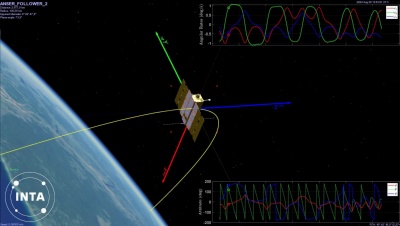- 30/09/24 14:39
- Santiago Rodriguez Bustabad

Disponer de dos satélites en órbita que hacen lo que se les comanda sin protestar ni poner escusas es un gusto. Llegar a este punto no es fácil y requiere el compromiso y dedicación de todo un equipo y, hay que reconocerlo, muchas iteraciones prueba-error.
En este momento, los dos Follwers de ANSER están maniobrando para acercarse a una distancia de 100km y esperar juntos la reintroducción del Leader-S. Su lanzamiento, en principio programado para el 1 de noviembre, ha sido post puesto por SpaceX hasta el 15 de enero de 2025, así es que se ha decidido que ambos follower esperen al tercer elemento a una altura en torno a los 520km. Esto da un cierto respiro al equipo de operaciones y se puede disfrutar haciendo experimentos en órbita no previstos de antemano.
Iván Castro de ADCS y Victor Prieto de OBSW han preparado y ejecutado con éxito sobre Follower2 una demostración del efecto Dzhanibekov o teorema de la raqueta de tenis. El resultado de la operación fue correctamente registrado por la telemetría del satélite y reproducida después en Tierra por medio de la aplicación VTS.
Compartimos como adelanto el texto y vídeos que Iván y Víctor han preparado para ser publicados en la página web de la ESA.
Enjoy !!
In-Orbit Demonstration of the Dzhanibekov Effect
The ANSER mission, with two Follower satellites in orbit since October 2023 and a Leader satellite planned to be launched in November 2024, has already achieved most of the mission objectives. An example is the differential drag concept that has allowed to perform continuous passive formation flying maneuvers to control the relative position between both Followers. The differential drag control has two key elements: the aerodynamic flaps, that increase the minimum area of the 3U CubeSats by a factor of 21, and the Attitude Determination and Control Subsystem (ADCS), that changes the satellites angle of attack by performing the required attitude pointing.
The variety of onboard ADCS sensors and actuators and the fact that it allows full control by the operator have opened the possibility to use the ANSER platforms as in-orbit testbeds for advanced attitude control algorithms. Several tests were carried out during the commissioning phase. Indeed, an interesting example is the in-orbit demonstration of the Dzhanibekov effect, also known as tennis-racket or intermediate-axis theorem. This is a periodic and natural 180-degree flipping motion which appears in rigid bodies when spinning about their intermediate axis of inertia in torque-free conditions. It has been demonstrated several times in the International Space Station with different objects such as a T-handle (https://www.youtube.com/watch?v=1x5UiwEEvpQ). Moreover, a group of PhD and MSc. students (DZH Dynamics) managed to control this effect (triggering it and stopping it) through an inertia-morphing actuator during a parabolic flight campaign organized by ESA (https://www.esa.int/Education/Fly_Your_Thesis/Meet_the_team_DZH_Dynamics). However, to the best of our knowledge, an intended demonstration of the Dzhanibekov effect in a real satellite had never been performed until the two ANSER Followers did it.
The attached video shows a graphical reconstruction of the satellite position and attitude with real in-orbit data while performing the Dzhanibekov effect. The inertia tensor, that is critical in this effect, corresponds to the open-flaps configuration that converts the green Y axis into the intermediate axis of inertia. For completeness, the evolution of the angular rates (top-right) and attitude (bottom-right) is also shown. Initially, the satellite was brought to a Y-Thomson spin by the ADCS using only the magnetorquers, which entails a rotation of -1 deg/s about its intermediate axis. This is a tiny spinning rate that generates a very small gyroscopic rigidity, but it was enough to perform the Dzhanibekov test in safe conditions. Then, the attitude controller was switched off leaving the satellite in nearly torque-free conditions (only small environmental torques), which are necessary for the Dzhanibekov effect to occur. After this instant, the satellite performed about 10 attitude flips of 180 degrees, that are easily identified by following the green Y axis, in about 1.5h before tumbling due the external torques and low spinning rate.
This in-orbit demonstration of the Dzhanibekov effect not only captured the attention of the ANSER team but also opens new opportunities in this mission and the coming ones by INTA. As suggested by the DZH Dynamics team, this effect can be used to assist the current ADCS solution to perform more efficient attitude maneuvers, for instance saving battery. In addition, it has been shown the flexibility of small-satellite missions to achieve objectives that were initially not planned.
Click en la imagen para ver -Vídeo dzh
Click en la imagen para ver -Vídeo max-drag









